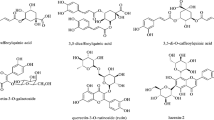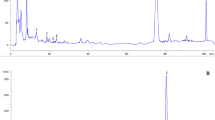Abstract
Emblica officinalis fruit is commonly used in Ayurvedic formulations for its role in prevention of various diseases. Its seeds have been found to enhance the antioxidant defences of the body in diabetic rats and its pulp methanolic extract is known for its antioxidant potential. However the antioxidant activity of the seed in comparison to pulp needs to be studied. A comparative study of the antioxidant potential of the whole fruit, seeds and pulp, respectively, is needed to identify which part of the fruit could be exploited for pharmaceutical or nutraceutical purposes. We compared the free radical scavenging capacity of the methanol extract of seed, pulp and whole fruit extract and also identified major flavonoids and phenolics by HPLC profiling. We also assessed the oxidized LDL- induced foam cell prevention and nitrite scavenging activity after LPS stimulation of RAW 264.7 macrophages. Pulp showed the highest antioxidant activity compared to seeds with IC50 values of 6 μg/ml and 13 μg/ml for DPPH radical scavenging assay and 41 and 70 μg/ml for nitric oxide scavenging activity, respectively. After 5 h incubation, among the three extracts studied, pulp showed the highest activity—88.89 % prevention of LDL oxidation, higher than that of the standard, ascorbic acid. Phytochemical analysis showed that phenolic content was highest in pulp and total tannins highest in seeds. HPLC profiling documented the presence of caffeic acid, coumaric acid, syringic acid and myricetin in both pulp and seeds with gallic acid present in pulp and tannic acid in seeds and whole fruit extract.



Similar content being viewed by others

References
AOAC (1990) Official methods of analysis of the Association of Official Analytical Chemists, 15th edn. Association of Official Analytical Chemists, Arlington, pp 1058–1059
Basniwal PK, Suthar M, Rathore GS et al (2009) In-vitro antioxidant activity of hot aqueous extract of Helicteres isora Linn. fruits. Natr Prod Rad 8:483–487
Bhattacharya A, Chatterjee A, Ghosal S, Bhattacharya SK (1999) Antioxidant activity of active tannoid principles of Emblica officinalis (amla). Indian J Exp Biol 37:676–680
Brand-Williams W, Cuvelier ME, Berset C (1995) Use of a free radical method to evaluate antioxidant activity. LWT-Food Sci Technol 28:25–30
Campos JF, dos Santos UP, Macorini LF, de Melo AM, Balestieri JB, Paredes-Gamero EJ, Cardoso CA, de Picoli SK, dos Santos EL (2014) Antimicrobial, antioxidant and cytotoxic activities of propolis from Melipona orbignyi (Hymenoptera, Apidae). Food Chem Toxicol 65:374–380
Carru C, Zinellu A, Galistu F, Barca M, Pasciu V, Lumbau F, Sanna B, Tadolini B, Deiana L (2004) The evaluation of the oxidative state of native-LDL: three methods compared. J Biochem Biophys Methods 61:271–281
Chang YC, Huang KX, Huang AC, Ho YC, Wang CJ (2006) Hibiscus anthocyanins-rich extract inhibited LDL oxidation and oxLDL-mediated macrophages apoptosis. Food Chem Toxicol 44:1015–1023
De Roos B, Rucklidge G, Reid M, Ross K, Duncan G, Navarro MA, Arbones-Mainar JM, Guzman-Garcia MA, Osada J, Browne J, Loscher CE, Roche HM (2005) Divergent mechanisms of cis9, trans11-and trans10, cis12-conjugated linoleic acid affecting insulin resistance and inflammation in apolipoprotein E knockout mice: a proteomics approach. FASEB J 19:1746–1748
Edwin K, Marion JJG, Ingeborg VDM, Monique NV, Peter H, Georg K, Marten HH, Menno PJDW (2004) Hematopoietic NF-κB1 deficiency results in small atherosclerotic lesions with an inflammatory phenotype. Blood 103:934–940
Ehala S, Vaher M, Kaljurand M (2005) Characterization of phenolic profiles of northern european berries by capillary electrophoresis and determination of their antioxidant activity. J Agric Food Chem 53:6484–6490
Evereklioglu C, Er H, Doganay S, Cekmen M, Turkoz Y, Otlu B, Ozerol E (2003) Nitric oxide and lipid peroxidation are increased and associated with decreased antioxidant enzyme activities in patients with age-related macular degeneration. Doc Ophthalmol 106:129–136
Filippin LI, Vercelino R, Marroni N, Xavier RM (2008) Redox signalling and the inflammatory response in rheumatoid arthritis. Clin Exp Immunol 152:415–422
Greenspan P, Yu H, Mao F, Gutman RL (1997) Cholesterol deposition in macrophages: foam cell formation mediated by cholesterol-enriched oxidized low density lipoprotein. J Lipid Res 38:101–109
Gülçin I, Oktay M, Küfrevioğlu Öİ, Aslan A (2002) Determination of antioxidant activity of lichen < i > Cetraria islandica(L). Ach J Ethnopharmacol 79:325–329
Gurib-Fakim A (2006) Medicinal plants: traditions of yesterday and drugs of tomorrow. Mol Aspects Med 27:1–93
Hyoung Lee S (1992) Antioxidative activity of browning reaction products isolated from storage-aged orange juice. J Agric Food Chem 40:550–552
Khan K (2009) Roles of Emblica officinalis in medicine-a review. Bot Res Int 2:218–228
Lee M-Y, Yuk J-E, Kwon O-K et al (2012) Zuonin B inhibits lipopolysaccharide-induced inflammation via downregulation of the ERK1/2 and JNK pathways in RAW264. 7 macrophages. Evid Based Complement Alternat Med 2012:1–8
Levitan I, Volkov S, Subbaiah PV (2010) Oxidized LDL: diversity, patterns of recognition, and pathophysiology. Antiox Redox Signaling 13:39–75
Libby P, Ridker P, Hansson G (2011) Progress and challenges in translating the biology of atherosclerosis. Nature 473:317–325
Marcocci L, Maguire JJ, Droylefaix MT, Packer L (1994) The nitric oxide-scavenging properties of Ginkgo biloba extract EGb 761. Biochem Biophys Res Commun 201:748–755
Mehta S, Rai PK, Rai DK, Nilesh Kumar Rai AK, Rai DB, Sharma B, Watal G (2010) LIBS-based detection of antioxidant elements in seeds of Emblica officinalis. Food Biophys 5:186–192
Niki E (2011) Do free radicals play causal role in atherosclerosis? Low density lipoprotein oxidation and vitamin E revisited. J Clin Biochem Nutr 48:3–7
Oktyabrsky O, Smirnova G (2007) Redox regulation of cellular functions. Biochem Mosc 72:132–145
Orrego R, Leiva E, Cheel J (2009) Inhibitory effect of three C-glycosylflavonoids from Cymbopogon citratus (Lemongrass) on human low density lipoprotein oxidation. Molecules 14:3906–3913
Packer L, Cadenas E, Davies KJ (2008) Free radicals and exercise: an introduction. Free Radic Biol Med 44:123–125
Pál P, Joseph SB, Lucas L (2007) Nitric oxide and peroxynitrite in health and disease. Physiol Rev 87:315–424
Patel D, Desai S, Gajaria T et al (2013) Coriandrum sativum l. Seed extract mitigates lipotoxicity in RAW 264.7 cells and prevents atherogenic changes in rats. Excli J 12:313–334
Price ML, Butler LG (1977) Rapid visual estimation and spectrophotometric determination of tannin content of sorghum grain. J Agric Food Chem 25:1268–1273
Prieto P, Pineda M, Aguilar M (1999) Spectrophotometric quantitation of antioxidant capacity through the formation of a phosphomolybdenum complex: specific application to the determination of vitamin E. Anal Biochem 269:337–341
Ribera AE, Reyes-Díaz M, Alberdi M, Zuñiga GE, Mora ML (2010) Antioxidant compounds in skin and pulp of fruits change among genotypes and maturity stages in Highbush Blueberry (Vaccinium corymbosum L.) grown in Southern Chile. J Soil Sci Plant Nutr 10:509–536
Ruangchakpet A, Tanaboon S (2007) Effect of browning on total phenolic, flavonoid content and antioxidant activity in Indian Gooseberry (Phyllanthus emblica Linn.). Kasetsart J (Nat Sci) 41:331–337
Sima A, Bulla A, Simionescu N (1990) Experimental obstructive coronary atherosclerosis in the hyperlipidemic hamster. J Submicrosc Cytol Pathol 22:1–6
Sroka Z (2005) Antioxidative and antiradical properties of plant phenolics. Z Naturforsch 60c:833–843
Vieira FGK, da Silva G, Borges C, Copetti C, Gonzaga LV, da Costa E, Nunes RF (2009) Activity and contents of polyphenolic antioxidants in the whole fruit, flesh and peel of three apple cultivars. Arch LatinoAm De Nutr 59:101–106
Wasaporn C, Jurriaan M, Robert AMV, Huub FJS, Harry JW (2010) Transcription profiles of LPS-stimulated THP-1 monocytes and macrophages: a tool to study inflammation modulating effects of food-derived compounds. Food Funct 1:254–261
Acknowledgments
The research was funded by the Council of Scientific and Industrial Research (CSIR), India.
Author information
Authors and Affiliations
Corresponding author
Additional information
Highlights
• Among the three extracts, pulp methanolic extract had the highest antioxidant activity
• Pulp had the highest foam cell preventing and nitrite scavenging activity in RAW 264.7 cells
• Pulp extract showed highest phenolic content and seed extract showed highest tannin content
• HPLC analysis indicated gallic acid in pulp and tannic acid in seeds and whole fruit extract
• Quercetin and gallic acid were found to be present only in pulp and absent in seeds.
Rights and permissions
About this article
Cite this article
Nambiar, S.S., Paramesha, M. & Shetty, N.P. Comparative analysis of phytochemical profile, antioxidant activities and foam prevention abilities of whole fruit, pulp and seeds of Emblica officinalis. J Food Sci Technol 52, 7254–7262 (2015). https://doi.org/10.1007/s13197-015-1844-x
Revised:
Accepted:
Published:
Issue Date:
DOI: https://doi.org/10.1007/s13197-015-1844-x



